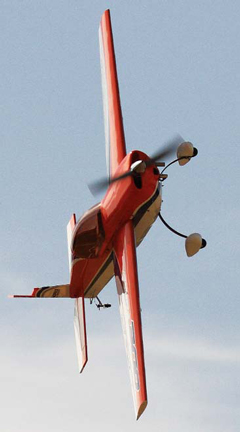| FLY RC MAGAZINEFLIGHT REPORT | by David Pinegar |
A Refined Aerobatic Thoroughbred In A .06/.09 Size
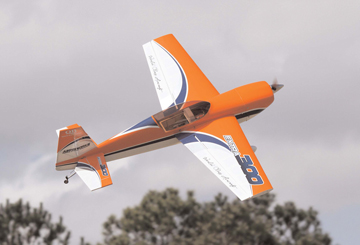 Through the last two decades there have been many Extra 300s modeled, but there are only a few manufacturers that listen to their customers and refine their models. Aeroworks is one of those few! In its introduction of its .60/.90 size version, it incorporated the requests of its customers and added to its successful line of Quick Build series of aircraft.
Through the last two decades there have been many Extra 300s modeled, but there are only a few manufacturers that listen to their customers and refine their models. Aeroworks is one of those few! In its introduction of its .60/.90 size version, it incorporated the requests of its customers and added to its successful line of Quick Build series of aircraft.
ASSEMBLY
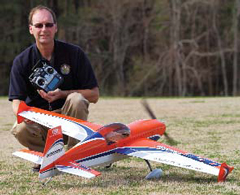 Out of the box, every part was carefully wrapped and packed for shipment. A well-written, 55-page assembly manual is also includeda change from the usual CD-ROM. Before starting this assembly, have all the necessary items at hand to complete the airplane; this ensures the assembly process goes quickly. Go to the Aeroworks website and check out the accessories and options that are available for the Extra.
Out of the box, every part was carefully wrapped and packed for shipment. A well-written, 55-page assembly manual is also includeda change from the usual CD-ROM. Before starting this assembly, have all the necessary items at hand to complete the airplane; this ensures the assembly process goes quickly. Go to the Aeroworks website and check out the accessories and options that are available for the Extra.
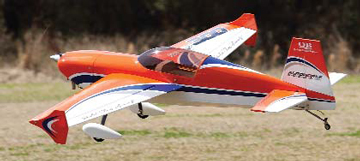 In excellent detail, the manual gives three motor options: 20cc gas, 2- and 4-stroke glow and electric. A fourth was added as an option when the DLE 20 introduced, which is the engine I chose. All are well written.
In excellent detail, the manual gives three motor options: 20cc gas, 2- and 4-stroke glow and electric. A fourth was added as an option when the DLE 20 introduced, which is the engine I chose. All are well written.
Tighten any loose covering, and use a sock over the iron to prevent scratching of the Ultracoat covering. Ailerons are pre-hinged but have to be CA glued in place, leaving a gap big enough to get 90 degrees of total travel. Once glued, I always give them a good tug to make sure the control surfaces are firmly attached.
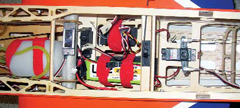
Hitecs HS-5665MH provides 122 ounce-inches of torque at 6 volts and 138 at 7.4. The entire aircraft is powered by a single LiFe Source Lithium-Iron-Phosphate battery from Hobbico. At 2100mAh and 6.6 volts, this 2-cell pack provides more than ample power for both flight pack and ignition module!
Fuselage assembly goes quickly; I assembled the carbonfiber main landing gear, wheels and fiberglass wheel pants. The carbonfiber gear is tapered and is a welcome addition to this model. Bolt this unit to the fuselage and then add the tail section. The horizontal stabilizer is epoxied in place and is lined up parallel to the carbon fiber wing tube. The one-piece elevator is hinged with CA to the stabilzer. Remember again, to leave enough gap for the 3D deflection in the hinging.
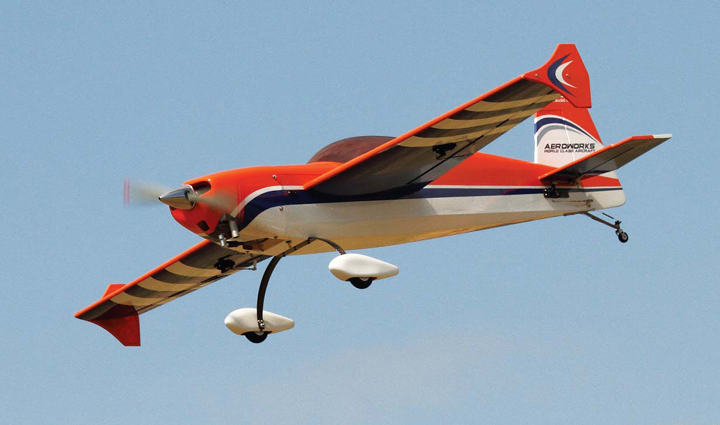
A control horn is bolted to one of the elevator halves, and a short pushrod connects the elevator to the tail mounted servo. The rudder is glued into place with CA and controlled via a pull/pull system. The tailwheel bolts to the bottom of the fuselage.
RADIO INSTALLATION
Aeroworks recommends 80 in./oz. servos for all the control surfaces. I used Hitec HS-5665MH digital servos, which produce 122 oz./in. at 6.0V and 139 oz./in. at 7.4V. They are standard size and they are very compatible with Hobbicos 6.6V LiFe flight pack. A standard Futaba S3003 was used for the throttle.
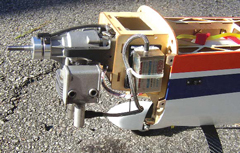
Fitting nicely under the cowling, the DLE 20 mounts to standard nylon beam mounts. Some modification is required to clear the motor box for the carburetor. Aeroworks has the DLE 20 mod kit available. It shows all the necessary steps to mount this little gasser.Servo extensions are easily fed through the wing with the pre-positioned string for the aileron servos.
Standard Aeroworks hardware is provided for the connection between the servos and control surfaces on the wing. It is recommended to use separate channels for each aileron and then mix them at the transmitter. The rudder servo is mounted mid-fuselage with pull/pull cables to the included rudder hardware. The elevator servo is mounted in the tail with a short pushrod. Its servo extension is fed through laser slots in the fuselage formers; this prevents the wire from flying around the fuse. Nice touch!
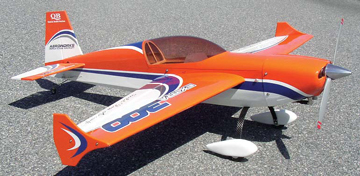 A beautiful Ultracoat finish. Someone spent a lot of time cutting out the radi on this covering job and it looks great! Carbon fiber landing gear has always been on the Aeroworks customer want list, and they came through!
A beautiful Ultracoat finish. Someone spent a lot of time cutting out the radi on this covering job and it looks great! Carbon fiber landing gear has always been on the Aeroworks customer want list, and they came through!
To power the radio and save weight, I chose Hobbicos new LiFe source Lithium-Iron-Phosphate batteries. At 2100mAh, the 6.6V 2-cell pack provides more than ample power!
With two universal connectors, one 10A Deans Ultra connector and a balance plug, there are a couple of options in how this battery is connected. I was able to use one Futaba heavy duty switch harness plugged into an unused channel on the Futaba R617FS receiver. The other connection is used to power DLEs ignition.
ENGINE INSTALLATION
Included are all the necessary items for the various engine installations: beam mounts, motor box, shims and linkage hardware, etc.
The reasons I chose the DLE 20 are it provides 2.5hp at 9000 rpm and weighs 28 ounces, and includes a standard electronic-ignition module and a standard side-mount muffler. At the time of this writing, a wraparound Pitts style muffler isnt yet available for this engine, but one should be on the market soon. The DLEs side-mounted muffler protrudes about 3/8 inch out of the bottom of the cowl, however, it doesnt detract from the Extras sleek lines.
The Aeroworks DLE installation kit was used, and it includes all the necessary hardware and a 13-page installation manual. Modification of the motor box is required for clearance of the rear mounted carburetor. A moto-tool was used to remove the excess wood required for the fit. I used the standard nylon-beam motor mount. The thrust lines are marked on the motor box, so its easy to line up the DLE.
Also included is the hardware for the remote-mounted choke. A short pushrod connected to a 90-degree bell crank exits the bottom of the fuselage and keeps the choke control hidden but available. The throttle servo location was moved behind the spar tube and a new wood servo tray was epoxied into place. Its pushrod runs through the right/center of the fuselage next to the fuel tank. As I used a gas engine, I only needed an 8 ounce tank, which provided a weight savings! The ignition module is zip-tied in place on the motor boxs side, and the fuel tank is assembled, installed and vented under the cowling. Included is a fuel dot that Ts into the fuel tank. I used a Zinger 16 x 6 wood propeller and a generic aluminum spinner from an old project. 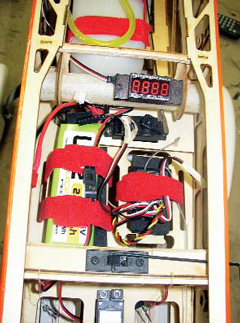
Mounted on the spar tube is a mini tachometer by Rcexi that plugs into Hall sensor. I was able to tune the engine safely from behind the airplane. It uses between 25 and 60mA and weights half an ounce. It has a self test feature and can give you any indications of ignition trouble.
To ensure the Aeroworks Extra will live up to its Quick Build reputation, have all the items and options required to complete it on hand before you start this project! Review the instruction manual. Aeroworks and DLE have their instruction manuals online for review, so these should answer all of your questions.
TIPS FOR SUCCESS
Balancing the Extra at 21/2 inches from the leading edge required only one ounce of stick-on lead weight under the horizontal stabilizer. This provided a neutral stable line of flight in right-side-up and inverted flight.
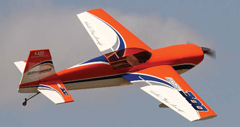
The DLE 20 starts easily with a standard 12V starter and a little choking, and settles into idle around 1,750 rpm. Taxing out to the runway requires a little up elevator. As I powered up the Extra, less than half throttle was required to become airborne.
I set up the control throws to the recommendations in the manual for low, high and 3D rates. They seemed to be on target for snapping maneuvers and giving me enough time to recover to the same attitude at which I started. The tendency is to over rotate the snap. Practice and timing will hone yours skill with this aerobatic thoroughbred. Switching to 3D rates, I found that the Extra hovers at a little above half throttle. Power management is the key to maintain heading in the hover; use of opposite aileron will help control torque. This airplane will do whatever 3D maneuver you ask of it. Landing the Extra 300 is straight forward: power off and it will settle in for a 3-point, fullstall landing. Add some throttle and speed and you can do nice wheel landings. The Extras carbon-fiber gear can handle the abuse. I added the side force generators to the Extra and the knife-edge maneuvers required less rudder input to hold altitude. When landing, make sure you have the wings level, owing to the clearance of the side force generators and the ground. |
|
PLANE: .60/.90 Extra 300 MANUFACTURER & DISTRIBUTOR: Aeroworks TYPE: Mid-wing aerobat FOR: Intermediate to advanced pilots WINGSPAN: 60.5 in. WING AREA: 690 sq. in. WEIGHT: 7 lb., 10 oz. WING LOADING: 25.46 oz./sq. ft. WING CUBE LOADING: 11.63 LENGTH: 56 in. RADIO: 6 channels required; flown with Futaba T12FGA transmitter, Futaba R617FS 7-channel 2.4 FASST receiver, Hitec HS-5665MH digital servos and a Futaba S3003 servo for throttle. ENGINE: 20cc gas; DLE-20 standard muffler PROPELLER/SPINNER: Zinger 16-6, 2 ¼-in. plastic spinner provided TOP RPM: 9,100 FUEL: 30:1 gas/oil mix ONBOARD BATTERY: one 2S 2100mAh 6.6V Hobbico LiFe for the receiver and ignition. PRICE: $284.95 COMPONENTS NEEDED TO COMPLETE: 20cc gas engine or .60 to .90 glow or electric motor, 4 high-torque servos, throttle servo, ignition and receiver battery, propeller and servo extensions. Optional items used were the DLE installation kit, DLE onboard tach, side force generators and Custom Vinyl Decal Set. All are available through Aeroworks. SUMMARY: The Aeroworks .60/.90 Extra 300 has sleek lines and an excellent use of color and color design. Add the vinyl graphics and this little gem will really shine on the flight line. Its assembly is quick and easy. The DLE 20 has the power to accelerate the Extra through any unlimited vertical line that you ask it to do! |
CONCLUSION
Aeroworks has gone out of there way to provide the RC modeler with a top-notch airplane such as this Extra 300excellent workmanship, laser-cut wood, no sloppy glue joints and everything fits well. With its use of curves in the design, the color scheme on this model makes this a thing of beauty!
Links
Aeroworks, (303) 371-4222
DLE Engines, distributed by Great Planes Model Distributors, (800) 682-8948
Futaba, distributed exclusively by Great Planes Model Distributors, (800) 682-8948
Hitec USA, (858) 748-6948
Hobbico, (800) 682-8948
Zinger Propellers, (310) 539-2313
 Fly RC Magazine WE LIVE RC
Fly RC Magazine WE LIVE RC
